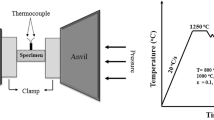Conclusions
The variation of the technological plasticity of the metals tested with an increase of the rate of cold upsetting from 0.001 to 25–100 m/sec is explained by the difference in the degree of heterogeneity of the structure formed. The reason for the impaired plasticity of alloys with an austenitic structure is the pronounced heterogeneity of the deformation structure.
The improved plasticity of aluminum-base alloys (AK6, AK8, AV) is due to the greater uniformity of the deformation structure.
In steel 45 and 40KhNMA the localization and irregularity of deformation increase to the same extent at all deformation rates tested.
Similar content being viewed by others
Literature cited
S. I. Gubkin, Plastic Deformation of Metals, Vol. 1 [in Russian], Moscow, Metallurgizdat (1960).
Additional information
ÉNIKMASh. Translated from Metallovedenie i Termicheskaya Obrabotka Metallov, No. 6, pp. 30–33, June, 1967.
Rights and permissions
About this article
Cite this article
Sogrishin, Y.P., Orlova, L.M. Influence of deformation rate on the plasticity of certain steels and alloys. Met Sci Heat Treat 9, 433–435 (1967). https://doi.org/10.1007/BF00657588
Issue Date:
DOI: https://doi.org/10.1007/BF00657588




